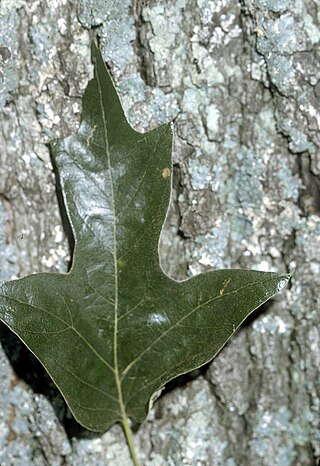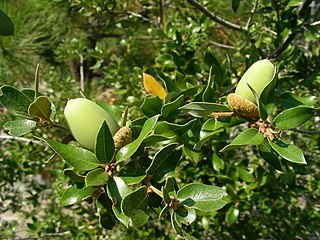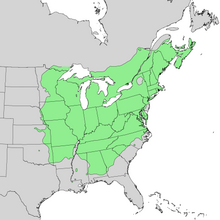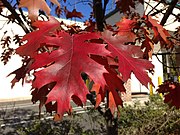
An oak is a hardwood tree or shrub in the genus Quercus of the beech family. They have spirally arranged leaves, often with lobed edges, and a nut called an acorn, borne in a cup. The genus is widely distributed in the Northern Hemisphere; it includes some 500 species, both deciduous and evergreen. Fossil oaks date back to the Middle Eocene. Molecular phylogeny shows that the genus is divided into Old World and New World clades, but many oak species hybridise freely, making the genus's history difficult to resolve.

Quercus kelloggii, the California black oak or Kellogg oak, is an oak in the red oak section native to western North America. Although genetically separated from them for more than 20 million years, its leaves are remarkably similar in appearance to several other members of the red oak section including the red oak and the black oak found in eastern and central North America.

Quercus alba, the white oak, is one of the preeminent hardwoods of eastern and central North America. It is a long-lived oak, native to eastern and central North America and found from Minnesota, Ontario, Quebec, and southern Maine south as far as northern Florida and eastern Texas. Specimens have been documented to be over 450 years old.

Quercus palustris, also called pin oak, swamp oak, or Spanish oak, is a tree in the red oak section of the genus Quercus. Pin oak is one of the most commonly used landscaping oaks in its native range due to its ease of transplant, relatively fast growth, and pollution tolerance.

Quercus velutina, the black oak, is a species of oak in the red oak group, native and widespread in eastern and central North America. It is sometimes called the eastern black oak.

Quercus robur, the pedunculate oak, is a species of flowering plant in the beech and oak family, Fagaceae. It is a large tree, native to most of Europe and western Asia, and is widely cultivated in other temperate regions. It grows on soils of near neutral acidity in the lowlands and is notable for its value to natural ecosystems, supporting a very wide diversity of herbivorous insects and other pests, predators and pathogens.

Quercus suber, commonly called the cork oak, is a medium-sized, evergreen oak tree in the section Quercus sect. Cerris. It is the primary source of cork for wine bottle stoppers and other uses, such as cork flooring and as the cores of cricket balls. It is native to southwest Europe and northwest Africa. In the Mediterranean basin the tree is an ancient species with fossil remnants dating back to the Tertiary period.

Quercus virginiana, also known as the southern live oak, is an evergreen oak tree endemic to the Southeastern United States. Though many other species are loosely called live oak, the southern live oak is particularly iconic of the Old South. Many very large and old specimens of live oak can be found today in the Deep South region of the United States.

Quercus agrifolia, the California live oak, or coast live oak, is a highly variable, often evergreen oak tree, a type of live oak, native to the California Floristic Province. It may be shrubby, depending on age and growing location, but is generally a medium-sized tree. It grows west of the Sierra Nevada mountain range from Mendocino County, California, south to northern Baja California in Mexico. It is classified in the red oak section of oaks.

Quercus laurifolia is a medium-sized semi-evergreen oak in the red oak section Quercus sect. Lobatae. It is native to the southeastern and south-central the United States.

Quercus douglasii, known as blue oak, is a species of oak endemic to California, common in the Coast Ranges and the foothills of the Sierra Nevada. It is California's most drought-tolerant deciduous oak, and is a dominant species in the blue oak woodland ecosystem. It is occasionally known as mountain oak and iron oak.

Quercus falcata, also called southern red oak, spanish oak, bottomland red oak or three-lobed red oak is an oak. Native to the southeastern United States, it gets its name the "Spanish Oak" as these are the areas of early Spanish colonies, whilst "southern red oak" comes from both its range and leaf color during late summer and fall. The southern red oak is a deciduous angiosperm, so has leaves that die after each growing period and come back in the next period of growth.

Quercus coccinea, the scarlet oak, is a deciduous tree in the red oak section Lobatae of the genus Quercus, in the family Fagaceae.

Quercus lobata, commonly called the valley oak or roble, grows into the largest of California oaks. It is endemic to California, growing in interior valleys and foothills from Siskiyou County to San Diego County. Mature specimens may attain an age of up to 600 years. This deciduous oak requires year-round access to groundwater.

Quercus castaneifolia, the chestnut-leaved oak, is a species of oak in the turkey oak section Quercus sect. Cerris. It is native to the Caucasus and Alborz mountains of Iran, and resembles the closely related Turkey Oak in appearance.

Quercus chrysolepis, commonly termed canyon live oak, canyon oak, golden cup oak or maul oak, is a North American species of evergreen oak that is found in Mexico and in the western United States, notably in the California Coast Ranges. This tree is often found near creeks and drainage swales growing in moist cool microhabitats. Its leaves are a glossy dark green on the upper surface with prominent spines; a further identification arises from the leaves of canyon live oak being geometrically flat.

Quercus pagoda, the cherrybark oak, is one of the most highly valued red oaks in the southern United States. It is larger and better formed than southern red oak and commonly grows on more moist sites. Its strong wood and straight form make it an excellent timber tree. Many wildlife species use its acorns as food, and cherrybark oak makes a fine shade tree. Cherrybark oak was formerly considered to be a subspecies of southern red oak, Quercus falcata, subsp pagodifolia.

Quercus rotundifolia, the holm oak or ballota oak, is an evergreen oak native to the western Mediterranean region, with the majority on the Iberian Peninsula and minor populations in Northwest Africa. The species was first described by Jean-Baptiste Lamarck in 1785. It is the typical species of the Iberian dehesa or montado, where its sweet-astringent acorns are a source of food for livestock, particularly the Iberian pig. Its acorns have been used for human nourishment since the Neolithic era. It is placed in section Ilex. Some authors described it as a subspecies of Quercus ilex.

Notholithocarpus densiflorus, commonly known as the tanoak or tanbark-oak, is a broadleaf tree in the family Fagaceae, and the type species of the genus Notholithocarpus. It is native to the far western United States, particularly Oregon and California. It ranges from 15–40 meters in height, with a trunk diameter of 60–190 centimeters.

Quercus pyrenaica, also known as Pyrenean oak, or Spanish oak is a tree native to southwestern Europe and northwestern North Africa. Despite its common name, it is rarely found in the Pyrenees Mountains and is more abundant in northern Portugal and north and northwestern Spain.





























